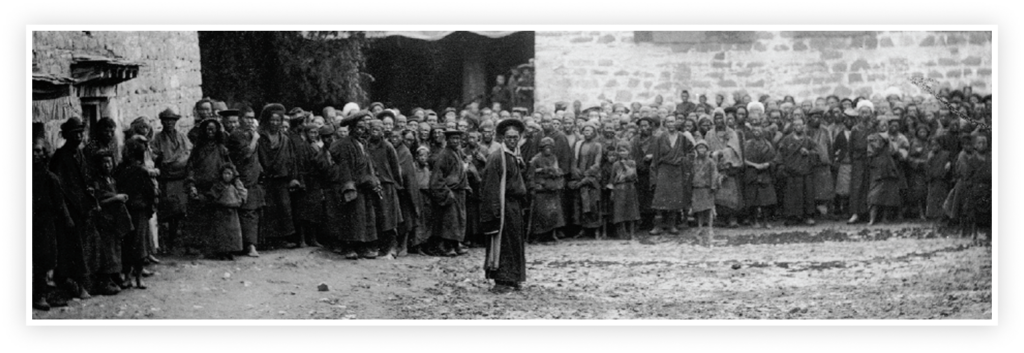Lhasa
We emerged from the dark enclosures of the Cathedral [Jokhang] into the blazing sunlight to find half the population of Lhasa waiting for us in a dense, growling crowd… The first stone came with a crash against the Do-ring [pillar] itself, missing Mr. White’s head by a few inches. It was the signal for a score of others.
Lhasa by Perceval Landon, 1905

View in Lhassa. Looking towards the Jokhang”. Photograph by John Claude White.
The British did not receive a warm welcome in Lhasa. Stories of massacres and destruction from Chumi Shonko and Gyantse were already circulating in the streets before they arrived. As a result the British were greeted with suspicion and unease when they marched into the city. Many of the photographs show how Tibetans reacted to their unwelcome guests.

British troops led by General Macdonald entering Lhasa, August 1904.
When the British reached Lhasa they visited the city’s bazaars, monasteries and temples, but the Tibetans resisted their presence with acts of protest. They gathered outside temples in case the British tried to loot sacred statues. They pelted the British with stones to show them they were not welcome and a monk from Sera Monastery was brave enough to enter the British camp and attack a British officer with a sword. The British hung him for his crime. Only a small number of photographs capture this tension. These rare photographs show Tibetans boldly staring at the camera and its British owner. The captions in the photograph album do not describe the Tibetans who stand in the way of the British.

John Claude White captioned this photograph, “View from terrace of Drepung Monastery”. He did not mention the Tibetans who were watching him very closely.
We emerged from the dark enclosures of the Cathedral [Jokhang] into the blazing sunlight to find half the population of Lhasa waiting for us in a dense, growling crowd… The first stone came with a crash against the Do-ring [pillar] itself, missing Mr. White’s head by a few inches. It was the signal for a score of others.
Lhasa by Perceval Landon, 1905

The British did not receive a warm welcome in Lhasa. Stories of massacres and destruction from Chumi Shonko and Gyantse were already circulating in the streets before they arrived. As a result the British were greeted with suspicion and unease when they marched into the city. Many of the photographs show how Tibetans reacted to their unwelcome guests.

When the British reached Lhasa they visited the city’s bazaars, monasteries and temples, but the Tibetans resisted their presence with acts of protest. They gathered outside temples in case the British tried to loot sacred statues. They pelted the British with stones to show them they were not welcome and a monk from Sera Monastery was brave enough to enter the British camp and attack a British officer with a sword. The British hung him for his crime. Only a small number of photographs capture this tension. These rare photographs show Tibetans boldly staring at the camera and its British owner. The captions in the photograph album do not describe the Tibetans who stand in the way of the British.
